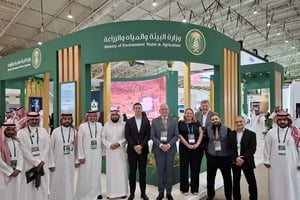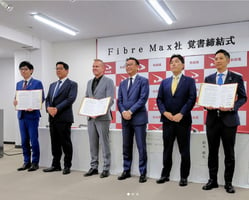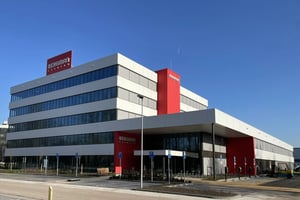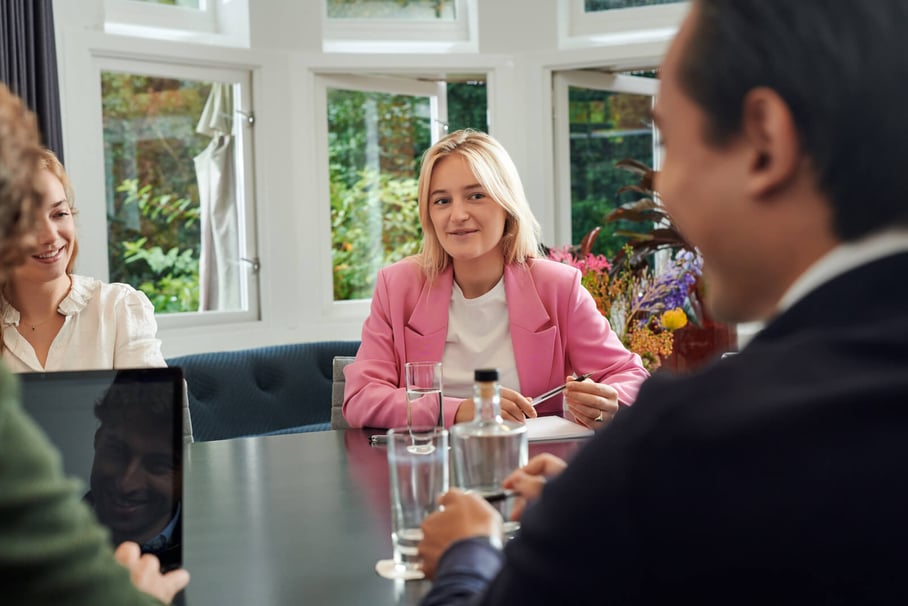Professor Jan Jonker (Radboud University Nijmegen) recently accepted the Emile Francqui Chair at the Free University of Brussels. In his inaugural address, he outlined a new economy – the WEconomy – which is based on a generation of new business models and a hybrid banking system. We put ten questions to Jan about our economy in transition.
1. Your research has focused on economic sustainability for many years. How would you describe the current economy?
“You cannot dispute the fact that our current economic model has given us a great deal, but it also has enormous downsides. We have become extremely smart at making things over time. However, these are the things that are now turning against us. The linear production economy with its unbridled consumption of raw materials, energy and water and huge waste production is no longer a sustainable model. I believe that you won’t solve this problem with a range of add-ons and end-of pipe solutions: we need to change the system. I don't mean radically dismantling the linear economy, because none of us is going to tin peas, make a tyre or any of the hundreds of thousands of things which we have access to thanks to linear production. However, we need to take radical action to combat the dark side of linear production. This means that we need to look at the principle of how we make and use things, which is the focus of my research.”
2. You have introduced an alternative economic model that you call the WEconomy. What exactly does this mean?
“The fact that our economy is working so well at the moment slightly hides the fact that we are currently in a transition. We are up against huge social change. If you step back, you will see three big movements: we are increasingly moving away from products to services; we are shifting from traditional production organisations to forming network organisations; and we are moving from a linear to a sustainable and circular economy. If you join the dots, you will end up with the WEconomy. The WEconomy is an economy that is circular, functional and bio-based all at the same time. It is also based on collaborating and sharing platforms and on self-production based on 3D printing. To conclude, this economy is characterised by digital connections between people, their devices, the processes and networks – the Internet of Things (IoT) and also the Internet of Services (IoS).”
3. That’s quite a mouthful. Can you expand on the seven aspects? Let's start with circularity. It's definitely a buzzword nowadays.
“That's true, unfortunately. The WEconomy is circular; it is based on the maximum reuse of products, parts and raw materials. The key concept behind it is based on organising the retention of the value of material, by minimising the value in destruction through redesigning, maintaining, reusing, refurbishing and substituting materials. To achieve this, we must consider the collective or individual thinking about things and their function. This last point has been overlooked too often, certainly by the government. I believe that a fundamental discussion about the issue of what part of our current economy lends itself to becoming circular is lacking. Plus, what this means for our way of production, for our calculation models and for the debates about added value and residual value. A circular economy is still some way off; for the time being, it is a wonderful idea. If we want to make progress in the next 10 to 20 years, we have a long way to go.”
4. The WEconomy is also functional and bio-based. What does this mean?
“A functional economy revolves less around selling products and more around selling functionality. It is happening already, but I think that in the next ten years, a vast number of new concepts – and as a result, business models – will be created that will utilise the functionality and the access that is developed by it. Spoiler alert: this may lead to sustainability, but the opposite may also be true. Improved utilisation is not by definition sustainable: using the same car more often is more sustainable per drive, but only in a limited fashion. A bio-based economy is about replacing raw materials. The key question is whether we can obtain raw materials in a different way. Could we grow them instead of mining them? What can you make with elephant grass, hemp fibres or algae? How and where can we create sufficient space to do this without harming our food supply?”
5. You also define the WEconomy as a collaborative economy.
“By this I predominantly mean new forms of collaboration to achieve collective value creation in networks. I think that soon a range of communities will be created to serve a whole host of market demands. These communities will be made up of prosumers. People will be producing and consuming at the same time, in communities. We will see a range of new collaborative ways of working between new and old parties, such as between citizens, between citizens and companies, between companies and governments, between companies and governments and NGOs. This will also create all sorts of new forms of value creation.”
6. The WEconomy also advocates a shift to a sharing economy and a self-producing (3D) economy. What’s new?
“The same applies here: we’re already seeing examples of this, but it will soon go much further. Nowadays, we often ask whether we ‘can use your car or drill via a platform’; in the WEconomy, it will revolve around developing smart concepts that allow consumers to better use a range of assets including a building, a heating installation, a car park, a hospital or a car. A key issue for me is that we start to think of this as early as the design phase, not when we have the final product; making something goes hand in hand with using it. A range of connections will be created between the functional economy, the sharing economy and the collaborative economy, which in turn will create a whole host of new business models. This also applies to the self-productive aspect of the economy. The linear economy is based on scale and volume, which in turn, leads to stock, transport and involves a lot of logistics and large warehouses. We will soon have an economy where we produce less stock and produce more custom products when we need them. This will solve a whole host of problems: we will use fewer raw materials, reduce the number of transport journeys and if we make smart choices in terms of the materials we use, we will also be able to reuse raw materials. Imagine that you suddenly don't need to go to IKEA every year to buy new garden furniture, but can commission the printing of your own chair based on your stock of plastic you are entitled to. You hand in your old furniture so that your raw material can continue to be used. All you have to do now is choose the design you want from the website. This creates a new business model based on the interface of circularity, 3D printing and collaboration.”
7. You have said that the six developments outlined above are connected to each other by the Internet of Things (IoT) and the Internet of Services (IoS). Can you tell us more about this?
“Over the last few decades, we have usually automated what we already had. We are now increasingly starting to see the opportunities that connections – and the data that is required – provide for our own products and services, in all manner of ways and sectors. A good example of this is the growth in the number of apps. Apps only appeared less than ten years ago and we now have upwards of 300 billion downloads. The IoT and IoS form a sort of Siamese twin that both lead to the rise in new technologies and alternative transaction models. An example to consider is the smart use of smart grids for the distribution and management of locally produced electricity.”
8. Am I right in saying that you predict the end of the ‘traditional’ business model and the rise of new business models based on the typical characteristics of the WEconomy?
“Absolutely. To cut to the chase: the Ostenwalder model – which is based on the belief that a business primarily focuses on organising a value proposition for a specific target group – has turned out to be too restrictive. Only one way of thinking is tolerated: what is the financial gain? Your success is measured by revenue. So, this automatically means that everything that has a negative impact is outsourced or, as it is so beautifully called, externalised. Nowadays, it's not a case of not being allowed to think in terms of finances, but it means that the costs that are involved or the destruction you are wreaking now or in the future are not taken into account. If you simply buy something as cheap as possible and make as much as possible for a certain target group and ultimately have more revenue and profit, then you have succeeded. I am in favour of rejecting this model and all other models that are consciously or unconsciously based on revenue. So, don't adjust a little bit and make a few things sustainable: simply replace it with another model with another way of thinking and other values. If you do this, you will end up with another group of business models. This can be split into three: platform business models, community-based business models and circular business models.
9. Can you briefly summarise what these business models are?
“The first group refers to models that enable the improved utilisation or supply of existing things – coordinating existing overcapacity based on digital networks. Similar business models ensure that fewer new products need to be made. An interesting development is the use of block chain in similar models, as a result of which, reliable, decentralised, peer-to-peer service can be further stimulated. Community-based business models are based on a form of community. People will collaborate to achieve value creation. For example, there is a need for mobility and this leads to car sharing. Or people focus on cooperating to generate joint energy. The third and most recent group are the circular business models. It's fair to say that it is best to describe this group of business models as in development. In any case, the crux of circular business models is the organisation of value retention. Parties must reach a collective business proposition. How can we intelligently organise certain materials such as tyres, bricks, paper, cement, plastics, glass, etc. so that we can experience the value it represents for longer and, as a result, this value is maintained?”
10. You believe that this type of new economy requires a different way to finance it. What will it be?
“Each economy is closely linked to the banking system, or in other words, the system of business transactions that banks arrange for us. You would be better off asking yourself whether value-creating transactions always need to take place with money. It's true that money is a useful method of transaction, but at the same time, it is not the only thing of value to people. Why can't you incorporate time as a value in an economic system? Or energy? Since we will start generating energy ourselves, maybe we will soon have a lot of residual energy that we can sell. Could you not create the value of mobility with your car when it is stationary up to 22 hours a day? In terms of waste, what is the value of a building that represents 30,000 tonnes of rubble? I predict that in the future, we will have more assets that we can use in transactions in a smart way. If you add up the different values, then you gain a system with hybrid values, a system that can be described as hybrid banking.”













